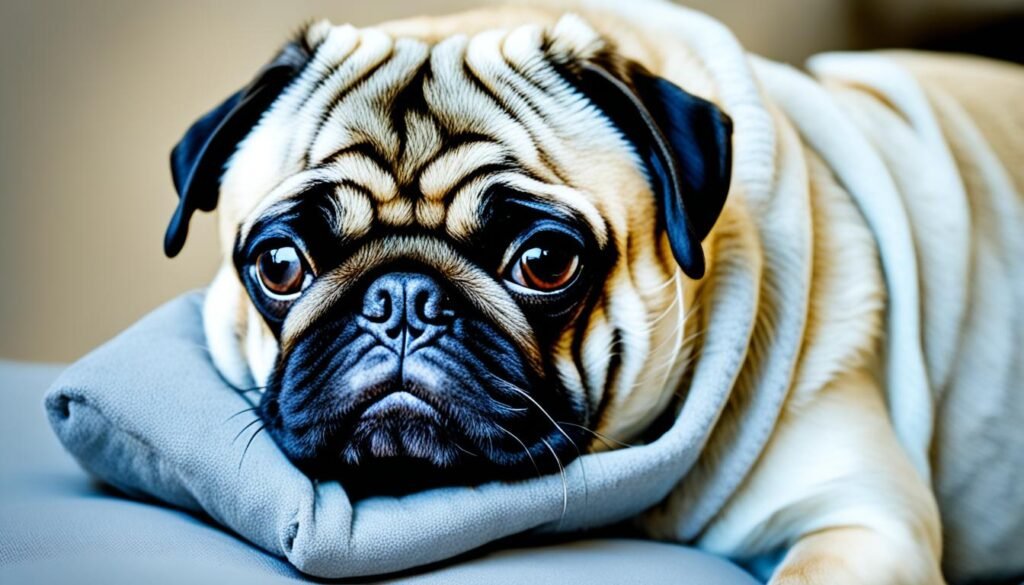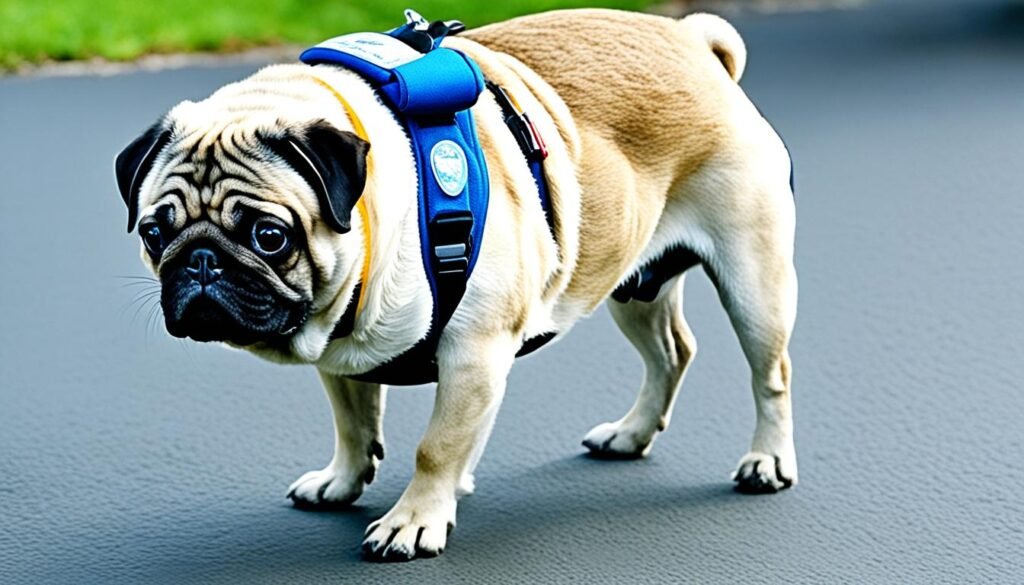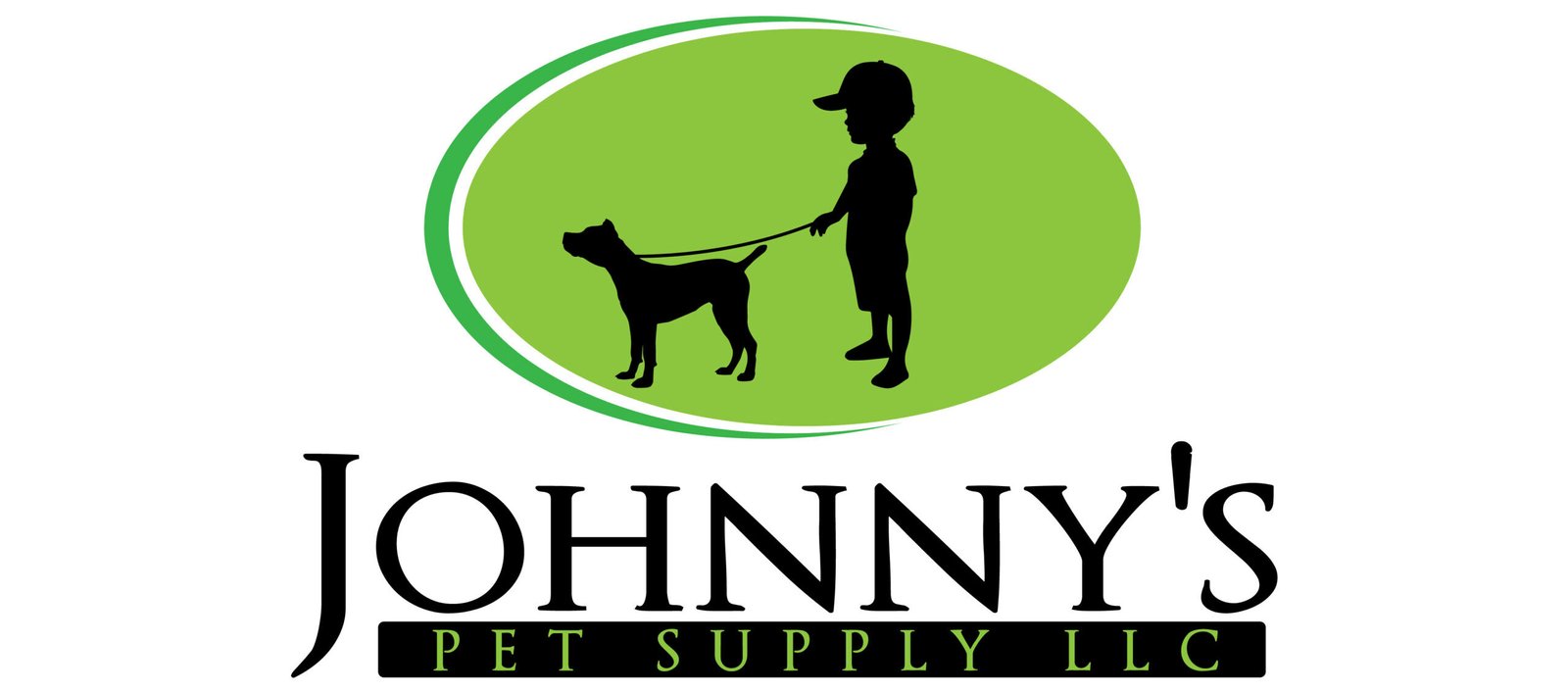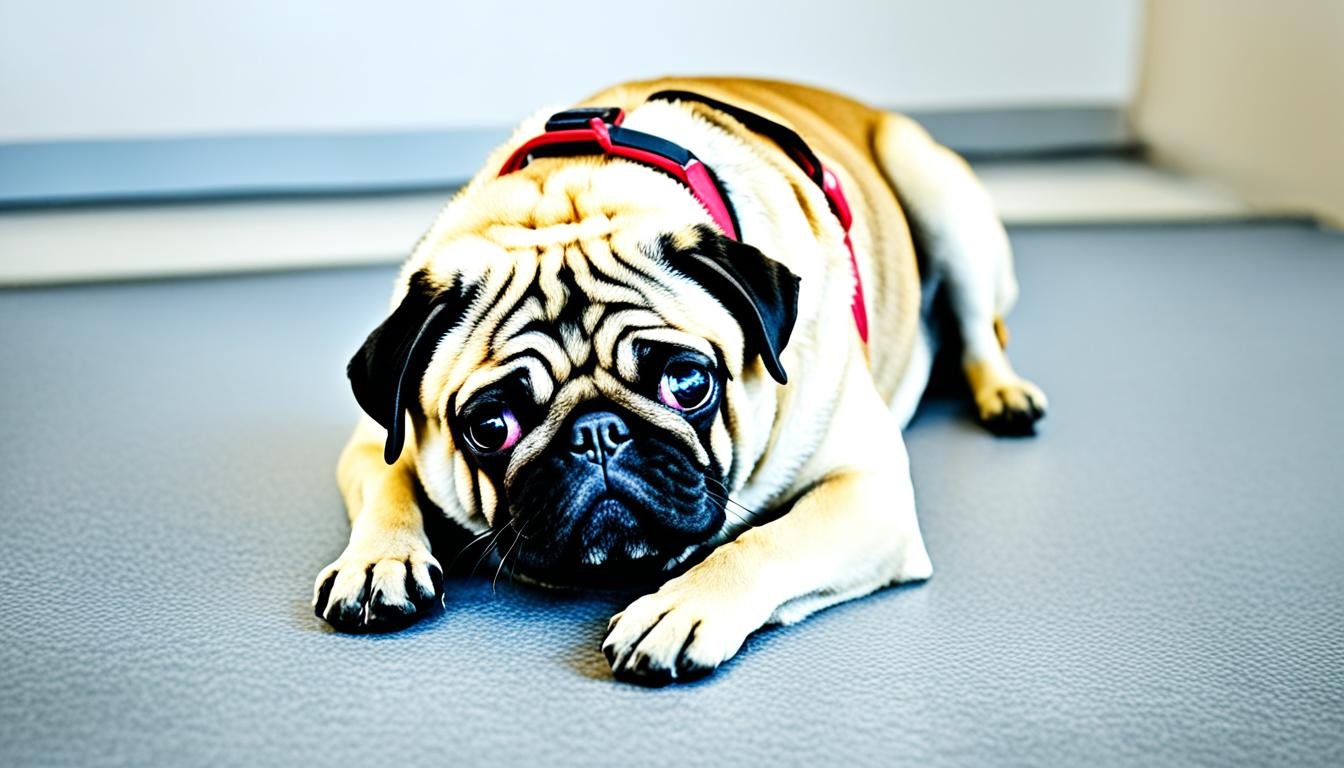How to avoid common health issues in Pugs
As a Pug owner, I know the joys and challenges of caring for these cute dogs. Pugs are loved for their unique looks, like their big eyes, curly tail, and flat face. But, these features can also lead to health problems. They often face issues such as breathing problems, cancer, and joint pain.
Learning about these health issues and how to prevent them is crucial. It helps me take the best care of my Pug and make sure it lives a long, healthy life. Regular vet check-ups, a proper diet, exercise, and grooming are important. By being informed and proactive, I can help my Pug stay healthy and happy.
Understanding Brachycephalic Obstructive Airway Syndrome in Pugs
If you own a pug, it’s key to know about their breathing challenges. Pugs have a short muzzle and flat face, which makes them prone to Brachycephalic Obstructive Airway Syndrome (BOAS). This is a lifelong breathing problem.
Causes and Symptoms of BOAS
BOAS happens because of issues in the pug’s airways. These include narrow nostrils, a long soft palate, and a small windpipe. These problems make breathing hard for pugs. They can lead to symptoms like trouble exercising, being sensitive to heat, noisy breathing, and stomach issues.
Managing BOAS Through Exercise, Weight Control, and Surgery
Even though brachycephalic obstructive airway syndrome in pugs is due to their breed, owners can help. Limiting exercise, keeping a healthy weight, and surgery in severe cases can ease symptoms. It’s important to keep pugs cool and not let them overdo it to manage their BOAS.

Preventing Cancer in Pugs: Oral Melanoma and Mast Cell Tumors
Pugs are cherished pets that need our best care for their health. Sadly, cancer is a big concern for them, especially pug cancer, pug oral melanoma, and pug mast cell tumors.
Signs and Treatment of Mast Cell Tumors
Mast cell tumors (MCTs) are common in Pugs, hitting middle-aged to older dogs. They look like red, swollen lumps that can change size without warning. It’s important to check any strange growths with a vet right away.
Early catching and quick action are crucial for MCTs. Surgery is usually the first step, and sometimes, dogs need chemo or radiation later on.
Recognizing and Treating Oral Melanoma
Oral melanoma is another big worry for Pugs, mainly in young dogs with lots of mouth pigmentation. Look out for bleeding in the mouth or a cheek lump. Quick action is key for fighting oral melanoma.
Vets might suggest surgery, radiation, or both to treat this aggressive cancer.
By keeping an eye out and working with vets, Pug owners can help prevent and manage these cancers. This way, their Pugs can stay happy and healthy.

How to avoid common health issues in Pugs
Keeping our Pugs healthy is very important. We need to take steps to prevent common health problems. Regular vet visits are key for catching issues early, like Brachycephalic Obstructive Airway Syndrome (BOAS), cancer, joint problems, and eye issues.
It’s also important to keep our Pugs at a healthy weight. This means feeding them right and making sure they get enough exercise. Regular grooming helps prevent skin infections, which is part of pug preventive care. We should watch our Pugs for signs of trouble, like breathing problems, limping, or eye issues, and get vet help fast if we see them.
By taking these steps, we can help our Pugs live long, happy lives. With a bit of extra care, we can keep them healthy and enjoy many happy years together.
Addressing Patellar Luxation and Hip Dysplasia in Pugs
Pugs are cute but can face joint problems like patellar luxation and hip dysplasia. Patellar luxation means the kneecap slips, causing the leg to be unstable and lame. Owners might see their Pug hopping or skipping. Surgery is often the best option, but keeping them at a healthy weight and using glucosamine can help with mild cases.
Symptoms and Treatment Options for Patellar Luxation
Hip dysplasia is another issue for Pugs, where the hip joint doesn’t form right. This leads to loose joints, limping, and can cause osteoarthritis. Early treatment, like pain meds, physical therapy, and surgery for severe cases, is key for pug hip dysplasia. Keeping them from gaining too much weight also helps reduce joint stress and slow down the problem.

Knowing the signs of these joint issues and working with a vet can help manage pug patellar luxation and hip dysplasia. Keeping a healthy weight, exercising right, and getting timely treatment can help these lovely dogs stay active and comfy.
Caring for Your Pug’s Eyes: Preventing Corneal Ulcers and Dry Eye
As a Pug owner, you must watch closely for your furry friend’s eye health. Pugs often face eye issues like corneal ulcers and dry eye because of their face shape. It’s key to know these conditions and act early to keep your Pug healthy.
Understanding Entropion and Its Impact on Pug Eye Health
Entropion is a common eye problem in Pugs. It makes the eyelid roll inward, causing eyelashes to scratch the cornea. This can cause pain, swelling, and even corneal ulcers if not treated. Always check your Pug’s eyes for signs like redness or too much tearing. Sometimes, surgery is needed to fix this and protect the eyes.
Chronic dry eye, or Keratoconjunctivitis Sicca (KCS), is also common in Pugs. It happens when the eyes don’t make enough tears to keep the cornea moist. Signs include red eyes, squinting, and a thick, gooey discharge. Quick vet care and special eye drops can help manage this and prevent corneal ulcers.
Keeping your Pug’s eyes healthy is key to their overall care. By watching for eye problems and getting vet help early, you can stop serious issues like pug eye problems, pug corneal ulcers, and pug dry eye. Your Pug’s comfort and health are very important.
Maintaining Healthy Skin and Coat in Pugs
Pugs are cute but can face skin issues, like infections. Keeping up with grooming is key to their skin and coat health. Regular brushing, bathing, and cleaning their skin folds help a lot.
Grooming Tips to Prevent Skin Infections
Pugs often get skin infections, especially around their faces and tails. These areas can get wet and warm, perfect for bacteria and fungi. To avoid pug skin problems, brush their coat often to remove loose hair and spread their natural oils.
When you bathe your Pug, make sure to dry their skin well. Moisture can cause pug skin infections. Clean and dry the skin folds well. Watch for redness, swelling, or bad smells to catch problems early.
By following these pug grooming tips, you can keep your Pug’s skin and coat healthy. This lowers the chance of common skin issues. Taking care of their grooming needs is key to being a good Pug owner.
Dietary and Exercise Recommendations for Pugs
Keeping a healthy weight is key for Pugs. Too much weight can make breathing and joint problems worse. I work with my vet to find the right diet and portion sizes for my Pug. Short, easy walks or playtime sessions are better than one long hard one. This helps prevent my Pug from getting too hot and tired.
Supplements like glucosamine and chondroitin can help Pugs with joint health. They ease joint strain and boost mobility. A balanced pug diet and regular, moderate pug exercise help manage my Pug’s weight and keep them healthy.
It’s important to have regular vet check-ups. These visits help monitor my Pug’s health and catch any issues early. With the right care, my Pug can live a long, happy life.

